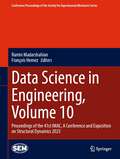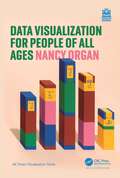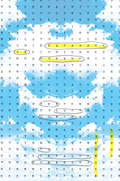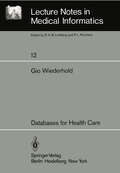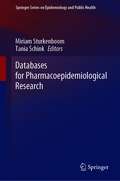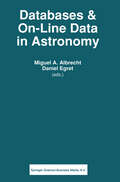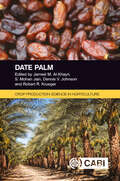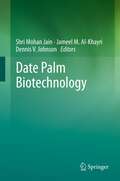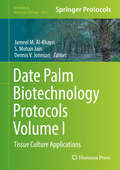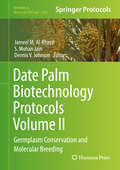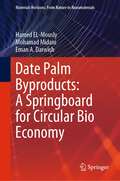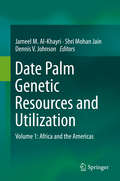- Table View
- List View
Data Science for Neuroimaging: An Introduction
by Ariel Rokem Tal YarkoniData science methods and tools—including programming, data management, visualization, and machine learning—and their application to neuroimaging researchAs neuroimaging turns toward data-intensive discovery, researchers in the field must learn to access, manage, and analyze datasets at unprecedented scales. Concerns about reproducibility and increased rigor in reporting of scientific results also demand higher standards of computational practice. This book offers neuroimaging researchers an introduction to data science, presenting methods, tools, and approaches that facilitate automated, reproducible, and scalable analysis and understanding of data. Through guided, hands-on explorations of openly available neuroimaging datasets, the book explains such elements of data science as programming, data management, visualization, and machine learning, and describes their application to neuroimaging. Readers will come away with broadly relevant data science skills that they can easily translate to their own questions.• Fills the need for an authoritative resource on data science for neuroimaging researchers• Strong emphasis on programming• Provides extensive code examples written in the Python programming language• Draws on openly available neuroimaging datasets for examples• Written entirely in the Jupyter notebook format, so the code examples can be executed, modified, and re-executed as part of the learning process
Data Science for Social Good: Philanthropy and Social Impact in a Complex World (SpringerBriefs in Complexity)
by Massimo Lapucci Ciro CattutoThis book is a collection of reflections by thought leaders at first-mover organizations in the exploding field of "Data Science for Social Good", meant as the application of knowledge from computer science, complex systems and computational social science to challenges such as humanitarian response, public health, sustainable development. The book provides both an overview of scientific approaches to social impact – identifying a social need, targeting an intervention, measuring impact – and the complementary perspective of funders and philanthropies that are pushing forward this new sector. This book will appeal to students and researchers in the rapidly growing field of data science for social impact, to data scientists at companies whose data could be used to generate more public value, and to decision makers at nonprofits, foundations, and agencies that are designing their own agenda around data.
Data Science in Engineering, Volume 10: Proceedings of the 41st IMAC, A Conference and Exposition on Structural Dynamics 2023 (Conference Proceedings of the Society for Experimental Mechanics Series)
by Ramin Madarshahian François HemezData Science in Engineering, Volume 10: Proceedings of the 41st IMAC, A Conference and Exposition on Structural Dynamics, 2023, the tenth volume of ten from the Conference brings together contributions to this important area of research and engineering. The collection presents early findings and case studies on fundamental and applied aspects of Data Science in Engineering, including papers on:Novel Data-driven Analysis MethodsDeep Learning Gaussian Process AnalysisReal-time Video-based AnalysisApplications to Nonlinear Dynamics and Damage DetectionHigh-rate Structural Monitoring and Prognostics
Data Science, Learning by Latent Structures, and Knowledge Discovery (Studies in Classification, Data Analysis, and Knowledge Organization)
by Berthold Lausen Sabine Krolak-Schwerdt Matthias BöhmerThis volume comprises papers dedicated to data science and the extraction of knowledge from many types of data: structural, quantitative, or statistical approaches for the analysis of data; advances in classification, clustering and pattern recognition methods; strategies for modeling complex data and mining large data sets; applications of advanced methods in specific domains of practice. The contributions offer interesting applications to various disciplines such as psychology, biology, medical and health sciences; economics, marketing, banking and finance; engineering; geography and geology; archeology, sociology, educational sciences, linguistics and musicology; library science. The book contains the selected and peer-reviewed papers presented during the European Conference on Data Analysis (ECDA 2013) which was jointly held by the German Classification Society (GfKl) and the French-speaking Classification Society (SFC) in July 2013 at the University of Luxembourg.
Data Science with Python: Combine Python With Machine Learning Principles To Discover Hidden Patterns In Raw Data
by Rohan Chopra Aaron England Mohamed Noordeen AlaudeenCombine Python with machine learning principles to discover hidden patterns in raw data
Data Science with R for Psychologists and Healthcare Professionals
by Christian RyanThis introduction to R for students of psychology and health sciences aims to fast-track the reader through some of the most difficult aspects of learning to do data analysis and statistics. It demonstrates the benefits for reproducibility and reliability of using a programming language over commercial software packages such as SPSS. The early chapters build at a gentle pace, to give the reader confidence in moving from a point-and-click software environment, to the more robust and reliable world of statistical coding. This is a thoroughly modern and up-to-date approach using RStudio and the tidyverse. A range of R packages relevant to psychological research are discussed in detail. A great deal of research in the health sciences concerns questionnaire data, which may require recoding, aggregation and transformation before quantitative techniques and statistical analysis can be applied. R offers many useful and transparent functions to process data and check psychometric properties. These are illustrated in detail, along with a wide range of tools R affords for data visualisation. Many introductory statistics books for the health sciences rely on toy examples - in contrast, this book benefits from utilising open datasets from published psychological studies, to both motivate and demonstrate the transition from data manipulation and analysis to published report. R Markdown is becoming the preferred method for communicating in the open science community. This book also covers the detail of how to integrate the use of R Markdown documents into the research workflow and how to use these in preparing manuscripts for publication, adhering to the latest APA style guidelines.
Data Science with R for Psychologists and Healthcare Professionals
by Christian RyanThis introduction to R for students of psychology and health sciences aims to fast-track the reader through some of the most difficult aspects of learning to do data analysis and statistics. It demonstrates the benefits for reproducibility and reliability of using a programming language over commercial software packages such as SPSS. The early chapters build at a gentle pace, to give the reader confidence in moving from a point-and-click software environment, to the more robust and reliable world of statistical coding. This is a thoroughly modern and up-to-date approach using RStudio and the tidyverse. A range of R packages relevant to psychological research are discussed in detail. A great deal of research in the health sciences concerns questionnaire data, which may require recoding, aggregation and transformation before quantitative techniques and statistical analysis can be applied. R offers many useful and transparent functions to process data and check psychometric properties. These are illustrated in detail, along with a wide range of tools R affords for data visualisation. Many introductory statistics books for the health sciences rely on toy examples - in contrast, this book benefits from utilising open datasets from published psychological studies, to both motivate and demonstrate the transition from data manipulation and analysis to published report. R Markdown is becoming the preferred method for communicating in the open science community. This book also covers the detail of how to integrate the use of R Markdown documents into the research workflow and how to use these in preparing manuscripts for publication, adhering to the latest APA style guidelines.
Data Stewardship for Open Science: Implementing FAIR Principles
by Barend MonsData Stewardship for Open Science: Implementing FAIR Principles has been written with the intention of making scientists, funders, and innovators in all disciplines and stages of their professional activities broadly aware of the need, complexity, and challenges associated with open science, modern science communication, and data stewardship. The FAIR principles are used as a guide throughout the text, and this book should leave experimentalists consciously incompetent about data stewardship and motivated to respect data stewards as representatives of a new profession, while possibly motivating others to consider a career in the field. The ebook, avalable for no additional cost when you buy the paperback, will be updated every 6 months on average (providing that significant updates are needed or avaialble). Readers will have the opportunity to contribute material towards these updates, and to develop their own data management plans, via the free Data Stewardship Wizard.
Data Stewardship for Open Science: Implementing FAIR Principles
by Barend MonsData Stewardship for Open Science: Implementing FAIR Principles has been written with the intention of making scientists, funders, and innovators in all disciplines and stages of their professional activities broadly aware of the need, complexity, and challenges associated with open science, modern science communication, and data stewardship. The FAIR principles are used as a guide throughout the text, and this book should leave experimentalists consciously incompetent about data stewardship and motivated to respect data stewards as representatives of a new profession, while possibly motivating others to consider a career in the field. The ebook, avalable for no additional cost when you buy the paperback, will be updated every 6 months on average (providing that significant updates are needed or avaialble). Readers will have the opportunity to contribute material towards these updates, and to develop their own data management plans, via the free Data Stewardship Wizard.
Data Visualization for People of All Ages (ISSN)
by Nancy OrganData visualization is the art and science of making information visible. On paper and in our imaginations, it’s a language of shapes and colors that holds our best ideas and most important questions. As we find ourselves swimming in data of all kinds, visualization can help us to understand, express, and explore the richness of the world around us. No matter your age or background, this book opens the door to new ways of thinking and sharing through the power of data visualization.Data Visualization for People of All Ages is a field guide to visual literacy, born from the author’s personal experience working with world-class scholars, engineers, and scientists. By walking through the different ways of showing data—including color, angle, position, and length—you’ll learn how charts and graphs truly work so that no visualization is ever a mystery or out of reach. It doesn’t stop at what fits on a page, either. You’ll journey into cutting-edge topics like data sonification and data physicalization, using sound and touch to share data across the different senses. Packed with practical examples and exercises to help you connect the dots, this book will teach you how to create and understand data visualizations on your own—all without writing a single line of code or getting tangled up in software.Written with accessibility in mind, this book invites everyone to the table to share the joy of one of today’s most necessary skills. Perfect for home or classroom use, this friendly companion gives people of all ages everything they need to start visualizing with confidence.
Data Visualization for People of All Ages (ISSN)
by Nancy OrganData visualization is the art and science of making information visible. On paper and in our imaginations, it’s a language of shapes and colors that holds our best ideas and most important questions. As we find ourselves swimming in data of all kinds, visualization can help us to understand, express, and explore the richness of the world around us. No matter your age or background, this book opens the door to new ways of thinking and sharing through the power of data visualization.Data Visualization for People of All Ages is a field guide to visual literacy, born from the author’s personal experience working with world-class scholars, engineers, and scientists. By walking through the different ways of showing data—including color, angle, position, and length—you’ll learn how charts and graphs truly work so that no visualization is ever a mystery or out of reach. It doesn’t stop at what fits on a page, either. You’ll journey into cutting-edge topics like data sonification and data physicalization, using sound and touch to share data across the different senses. Packed with practical examples and exercises to help you connect the dots, this book will teach you how to create and understand data visualizations on your own—all without writing a single line of code or getting tangled up in software.Written with accessibility in mind, this book invites everyone to the table to share the joy of one of today’s most necessary skills. Perfect for home or classroom use, this friendly companion gives people of all ages everything they need to start visualizing with confidence.
Data Warehousing for Biomedical Informatics
by Richard E. BiehlData Warehousing for Biomedical Informatics is a step-by-step how-to guide for designing and building an enterprise-wide data warehouse across a biomedical or healthcare institution, using a four-iteration lifecycle and standardized design pattern. It enables you to quickly implement a fully-scalable generic data architecture that supports your organization's clinical, operational, administrative, financial, and research data. By following the guidelines in this book, you will be able to successfully progress through the Alpha, Beta, and Gamma versions, plus fully implement your first production release in about a year.
Data Warehousing for Biomedical Informatics
by Richard E. BiehlData Warehousing for Biomedical Informatics is a step-by-step how-to guide for designing and building an enterprise-wide data warehouse across a biomedical or healthcare institution, using a four-iteration lifecycle and standardized design pattern. It enables you to quickly implement a fully-scalable generic data architecture that supports your organization's clinical, operational, administrative, financial, and research data. By following the guidelines in this book, you will be able to successfully progress through the Alpha, Beta, and Gamma versions, plus fully implement your first production release in about a year.
Database and Expert Systems Applications: DEXA 2018 International Workshops, BDMICS, BIOKDD, and TIR, Regensburg, Germany, September 3–6, 2018, Proceedings (Communications in Computer and Information Science #903)
by Mourad Elloumi Michael Granitzer Abdelkader Hameurlain Christin Seifert Benno Stein A Min Tjoa Roland WagnerThis volume constitutes the refereed proceedings of the three workshops held at the 29th International Conference on Database and Expert Systems Applications, DEXA 2018, held in Regensburg, Germany, in September 2018: the Third International Workshop on Big Data Management in Cloud Systems, BDMICS 2018, the 9th International Workshop on Biological Knowledge Discovery from Data, BIOKDD, and the 15th International Workshop on Technologies for Information Retrieval, TIR.The 25 revised full papers were carefully reviewed and selected from 33 submissions. The papers discuss a range of topics including: parallel data management systems, consistency and privacy cloud computing and graph queries, web and domain corpora, NLP applications, social media and personalization
Database of Dreams: The Lost Quest to Catalog Humanity
by Rebecca LemovJust a few years before the dawn of the digital age, Harvard psychologist Bert Kaplan set out to build the largest database of sociological information ever assembled. It was the mid-1950s, and social scientists were entranced by the human insights promised by Rorschach tests and other innovative scientific protocols. Kaplan, along with anthropologist A. I. Hallowell and a team of researchers, sought out a varied range of non-European subjects among remote and largely non-literate peoples around the globe. Recording their dreams, stories, and innermost thoughts in a vast database, Kaplan envisioned future researchers accessing the data through the cutting-edge Readex machine. Almost immediately, however, technological developments and the obsolescence of the theoretical framework rendered the project irrelevant, and eventually it was forgotten.
Databases for Cardiology (Developments in Cardiovascular Medicine #115)
by c. Stephen Foster Maite Sainz de la MazaA database is in principle just a large collection of related or separate data, systematically stored in a computer. It should be possible for the data to be easily entered into the database-structure and afterwards also easily read, corrected and processed. The later analysis of data from such a database is greatly enhanced by the availability of special query languages and statistical analysis programs, not only for serial items but also for large combinations of data. Query languages, such as SQL (Structured Query Language) developed especially for these purposes, make databases easily accessible, also to researchers who may not be very well versed in computer programming. The cardiological/medical clinician and researcher of today is of necessity confronted more and more with computer-based data storage. Interest is of course focused primarily on the clinical use of such databases more than on the technical design itself, except for some very specific, personalized applications. For the latter approach, there are at present many software packages commercially available, especially designed for use in the personal computer environment. This book is comprised out of a number of contributions by various authors with differing backgrounds and from many different countries. The editors, being a cardiologist and an information scientist, have strived to achieve an equilibrium between these two fields. The chapters in this book form a cross-section of the many approaches to database design and implementation in the area of cardiology.
Databases for Pharmacoepidemiological Research (Springer Series on Epidemiology and Public Health)
by Miriam Sturkenboom Tania SchinkThis book allows readers to gain an in-depth understanding of the role of real-world data in pharmacoepidemiology, and highlights the strengths and limitations of the respective databases with regard to pharmacoepidemiological research. Over the past decade, the increasing use of real-world data in pharmacoepidemiological research has been accompanied by a growing recognition of the value of real-world evidence in clinical and regulatory decision-making. Electronic healthcare databases allow analyses of drug and vaccine utilization in routine care after approval, as well as investigations of their comparative effectiveness and safety. They are especially useful for the identification of rare risks and rare drug exposures over long periods of time, and as such sustainably extend the basis for drug safety research. This book provides an introduction to the role of real-world data in pharmacoepidemiological research and the main developments in the last 15 years. It also offers a comprehensive overview of the general classification characteristics of databases, together with their strengths and limitations, and a detailed description of 21 individual databases, written by professionals who work with or maintain them.
Databases & On-line Data in Astronomy (Astrophysics and Space Science Library #171)
by M. A Albrecht D. EgretData archiving has, for many years, been the most disregarded aspect of all data systems. The increase in numbers of telescopes, both groundbased and space-borne, and the increase in efficiency of detectors have generated overwhelming amounts of data. Much of these data were and are not used on short timescales and (should) have been archived, where they can be used later and/or by others. Archiving is essential. Objects can change in the course of time. New technological or scientific developments might require observing objects again. The cost-benefit ratio will become more and more important when considering the allocation of telescope time. The retrieval of `old' data can then be crucial. At present there are a number of data collections and data retrieval systems. This book includes a series of clear and up-to-date descriptions of many important available data systems. For professional astronomers, librarians and computer engineers.
Date Palm (Crop Production Science in Horticulture)
by Dr Larbi Abahmane Dr Mohamed Ait-El-Mokhtar Dr Fatima-Zahra Akensous Dr M. Tahir Akram Dr Salah Mohammed Aleid Dr Melkamu Alemayehu Dr Abda Ali Dr Latifa Al-Kharusi Professor Jameel M Al-Khayri Dr Mohammed Al-Mahish Dr Abdulrasoul Mosa Al-Omran Dr Lyutha Al-Subhi Dr Rashid Al-Yahyai Asunción Amorós Dr Mohamed Anli Dr Mohamed Marouf Aribi Dr Raja Ben-Laoaune Dr Houda Besser Dr Neeru Bhatt Dr Abderrahim Boutasknit Dr Roshini Brizmohun Dr Latifa Dhaouadi Dr Gisela Díaz Dr Raga Elzaki Dr Abdessamad Fakhech Dr Mohamed Abusaa Fennir Dr Ibrahim E. Greiby Dr Ayah R. Hilles Professor Shri Mohan Jain Rhonda Janke Dr Muhammad Jafar Jaskani Professor Dennis V Johnson Dr Imran Ul Khan Dr M Mumtaz Khan Dr Rashad Rasool Khan Dr Robert R Krueger Dr Mithlesh Kumar Dr Abdelilah Meddich Dr C. M. Muralidharan Dr Summar Abbas Naqvi Dr Taseer Abbas Naqvi Dr Concepción Obón Dr Redouane Ouhaddou Dr Ozcan Ozturk Dr Ouissame Raho Dr Diego Rivera Dr Ricardo Salomón-Torres Dr Kapil Mohan Sharma Mostafa I. Waly Dr Muhammad Waseem Dr Glenn C. WrightDate palm (Phoenix dactylifera L.) is a tree belonging to the palm family (Arecaceae) and is cultivated for its sweet edible fruits. Over the past century, it has become a major commercial fruit crop and a key component of agricultural production in the world's subtropical arid and semiarid regions. A crop suited both to the low-input small-farmer and the modern high-input commercial plantation, the date palm provides a livelihood for millions of people living in marginal land areas where farming options are restricted. Date palm is mainly grown for its fruits, but the whole tree is utilized. Research into date palm improvement for fruit production in recent decades has brought about improved elite cultivars, stress and pathogen resistance, and enhanced postharvest technologies. These developments have led to revised recommendations for date palm producers, and increased opportunity to promote novel fruit products. This book provides: · A practical manual on modern date palm cultivation methods. · Best practice guidelines for optimal production levels of high-quality fruit. · Opportunities for more complete utilization of date palm products at both the subsistence and commercial levels of production. With contributions from leading international experts, this is a valuable resource for researchers and students in horticulture, as well as date palm growers and processors.
Date Palm Biotechnology
by Shri Mohan Mohan Jain, Jameel M. M. Al-Khayri and Dennis V. V. JohnsonThis important reference book is the first comprehensive resource worldwide that reflects research achievements in date palm biotechnology, documenting research events during the last four decades, current status, and future outlook. This book is essential for researchers, policy makers, and commercial entrepreneurs concerned with date palm. The book is invaluable for date palm biotechnology students and specialists. This monument is written by an international team of experienced researchers from both academia and industry. It consists of five sections covering all aspects of date palm biotechnology including A) Micropropagation, B) Somaclonal Variation, Mutation and Selection, C) Germplasm Biodiversity and Conservation, D) Genetics and Genetic Improvement, and E) Metabolites and Industrial Biotechnology. The book brings together the principles and practices of contemporary date palm biotechnology. Each chapter contains background knowledge related to the topic, followed by a comprehensive literature review of research methodology and results including the authors own experience including illustrative tables and photographs.
Date Palm Biotechnology Protocols Volume I: Tissue Culture Applications (Methods in Molecular Biology #1637)
by Jameel M. Al-Khayri, S. Mohan Jain and Dennis V. JohnsonThis two-volume book is a valuable resource to students, researchers, scientists, commercial producers, consultants and policymakers interested in agriculture or plant sciences particularly in date palm biotechnology. Date Palm Biotechnology Protocols, Volume 1: Tissue Culture and Applications is comprised of 27 chapters covering adventitious organogenesis, somatic embryogenesis, contamination, hyperhydricity, acclimatization, cell suspension, protoplast and bioreactors, genetic transformation secondary metabolites, and abiotic stress. Written in the highly successful Methods in Molecular Biology series format, chapters include introductions to their respective topics, lists of the necessary materials and reagents, step-by-step, readily reproducible laboratory protocols, and tips on troubleshooting and avoiding known pitfalls. Authoritative and practical, Date Palm Biotechnology Protocols, Volume 1: Tissue Culture and Applications aims to supplement the previous volume and to provide precise stepwise protocols in the field of date palm biotechnology.
Date Palm Biotechnology Protocols Volume II: Germplasm Conservation and Molecular Breeding (Methods in Molecular Biology #1638)
by Jameel M. Al-Khayri, S.Mohan Jain and Dennis V. JohnsonThis two-volume book is a valuable resource to students, researchers, scientists, commercial producers, consultants and policymakers interested in agriculture or plant sciences particularly in date palm biotechnology. Chapters in Date Palm Biotechnology Protocols: Volume 2: Germplasm Conservation and Molecular Breeding guides readers through methods and protocols on germplasm in vitro conservation, molecular analysis of in vitro cultures, genetic diversity, cultivar identity, gender identification, genomics, and proteomics. Written in the highly successful Methods in Molecular Biology series format, chapters include introductions to their respective topics, lists of the necessary materials and reagents, step-by-step, readily reproducible laboratory protocols, and tips on troubleshooting and avoiding known pitfalls.Authoritative and practical, Date Palm Biotechnology Protocols: Volume 2: Germplasm Conservation and Molecular Breeding aims to supplement the previous volume and to provide precise stepwise protocols in the field of date palm biotechnology.
Date Palm Byproducts: A Springboard for Circular Bio Economy (Materials Horizons: From Nature to Nanomaterials)
by Hamed EL-Mously Mohamad Midani Eman A. DarwishThis comprehensive book presents an alternative fresh look at date palm byproducts as a springboard for the future circular bio economy. The book shows and exemplifies how these sustainable biomaterials can be the base for a wide spectrum of products and uses. Examples of these numerous products and uses are demonstrated and categorized into five principal uses: i) pharmaceutical, cosmetics and natural wax ,ii) textiles and composites, cellulose and cellulose derivatives, iii)timber and wood substitutes, architecture insulation and building materials, iv) organic fertilizer, compost and soil amendment and water treatment purposes, v) natural fodder and silage , green fuels and bioenergy.
Date Palm Genetic Resources and Utilization: Volume 1: Africa and the Americas
by Jameel M. Al-Khayri Shri Mohan Jain Dennis V. JohnsonThis important 2-volume reference book is the first comprehensive resource reflecting the current global status and prospects of date palm cultivation by country. This volume covers Africa and the Americas. Countries included are: Egypt, Algeria, Sudan, Tunisia, Libya, Morocco, Mauritania, Niger, Cameroon, Djibouti, Chad, Mali Somalia, Ethiopia, Burkina Faso and Senegal, as well as the United States of America and the South American countries Chile and Peru. Topics discussed are: cultivation practices; genetic resources and breeding; conservation and germplasm banks; cultivar classification and identification based on morphological and molecular markers; micropropagation and progress toward scale-up production; and advances in dates processing and marketing. Chapters are supported by tables and color photographs. Appendixes summarize traits and distribution of major cultivars, commercial resources of offshoots and in vitro plants; and institutions and scientific societies concerned with date palm.


